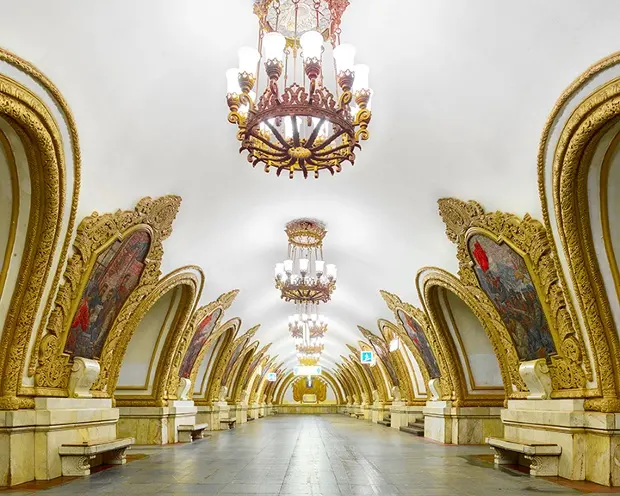MAY 1, 2022 – In Moscow I took mini-expeditions via the Metro. With a Metro map from my hotel, I found the closest station and entered the most ornately beautiful subway system in the world—and so far below the surface, it doubled as a far-flung bomb shelter. It was said that Lenin believed the workers should be afforded beautiful surroundings on their way to work (if not necessarily at work itself) and thus the stations were designed as mini-art museums. In my letter home, I wrote, “Each is adorned with beautiful mosaics, wall paintings or sculpture groups, and the elegant chandeliers are fit for some old, fashionable hotel. There’s no hint of graffiti or litter, and the entrance fee is just 5 kopeks or about 8¢.”
The subway cars themselves were heavy-duty. They were of the same make as the ones I’d ridden in Prague. There my Czech friends, Pavel and Magda, had carved out an exception to their savage indictment of all things Russian: “They make good subway cars,” Magda had said, with Pavel nodding in agreement.
Since the fare was cheap, I caught a ride at one station, rode past several stops, disembarked at a random station, went above ground, walked around for a look, took the long escalator back down to the station platform, hopped aboard the next subway and repeated the process multiple times. This method allowed for random samplings of Moscow neighborhoods. I also got to observe people aboard the subway and noticed how many of them were reading . . . hardcover books. When standing, I edged as close as I could to identify the material. On several occasions I saw text that looked like poetry.
On a walk outside one station I discovered a sizable park full of people enjoying the pleasant surroundings. At one end, I again encountered . . . the long queue. I followed it to the product being offered and found . . . Cuban bananas! But I was impressed by something else about that queue, perhaps because I was fresh off the subway, which, as noted above, doubled as a reading library. While people waited for their bananas, their faces were buried in books—not cheap paperbacks but what looked like serious reading.
I shouldn’t have been surprised, then, when I next encountered a queue at a kiosk selling classic Russian literature. Moreover, some selections were English and German translations. This sparked an idea for a quintessentially Russian experience: reading Gogol and Tolstoy on the Trans-Siberian Railway. I purchased two sets of short stories, which I thoroughly enjoyed in the fashion I’d imagined.
On one of my Metro surface-mini-expeditions, I visited the permanent, sprawling “Exposition of Economic Achievement.” It reminded me a bit of the “Merchandise Mart” at the Minnesota State Fair featuring lots of displays of underwhelming products. Yet, the driving force behind the “Merchandise Mart” was to move product. The notion of showcasing “economic achievements” at the perpetual “Exposition,” on the other hand, struck me as naive propaganda—a quaint attempt to convince people that Communism had, by golly, despite itself, produced . . . “economic achievements.” I viewed this quaintness, this naiveté as a reflection of an inferiority complex disguised as Russian chauvinism. It was a theme I would discern in many of my interactions with Russians aboard . . . the Trans-Siberian train.
(Remember to subscribe to this blog and receive notifications of new posts by email.)
© 2022 by Eric Nilsson
